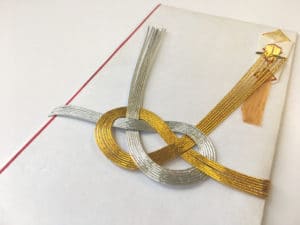Paper Wrapping as Ritual
 Although no longer an inexpensive wrap, receiving and giving a gift wrapped in washi, no doubt, evokes for paper lovers a seductive charm. For the Japanese, washi carries a deeper meaning; simply touching it resurrects nostalgic thoughts of the old days.
Although no longer an inexpensive wrap, receiving and giving a gift wrapped in washi, no doubt, evokes for paper lovers a seductive charm. For the Japanese, washi carries a deeper meaning; simply touching it resurrects nostalgic thoughts of the old days.
Cash, either in the form of paper bills or coins, is a gift given on so many occasions in Japan; New Year’s, coming of age, weddings, funerals, and births. It is proper etiquette to present money at all times enclosed in an envelope, the okane ire. Due to this ingrained aspect of Japanese culture, there are an abundant variety of money envelopes sold in Japan.

Noshi is an asymmetrical, diamond-like folded shape attached to gifts to express good wishes. Originally, noshi were made of white paper folded with a strip of dried abalone for good luck. There are various rules of etiquette surrounding noshi depending on the occasion. The noshi is generally placed in the upper right-hand side of a parcel or money envelope and always made from white paper. Paper is a fine layer of polite distance between giver and receiver, in other words, handing something directly (unwrapped) to someone is considered rude. Taking the time to wrap something implies the item within is a gift from the heart.

Here is a great description of the history of Origata from the MET:
“Since ancient times in Japan, decorative wrapping paper was a part of formal gift-exchange rituals, and knowledge of the art of paper folding (origata) was an essential skill of aristocrats and highranking warriors.
The origins of origata can be traced to the Heian period (794–1185), when several styles ofwrapping were developed, including that for poetry, money, and fans. With time several schools of paper wrapping were formed, including, most prominently, the Ogasawara School. Techniques were taught exclusively through oral transmission. By the Edo period, origata became prominent even among commoners.” ©https://www.metmuseum.org/art/collection/search/78428 also see: http://origata.com/
